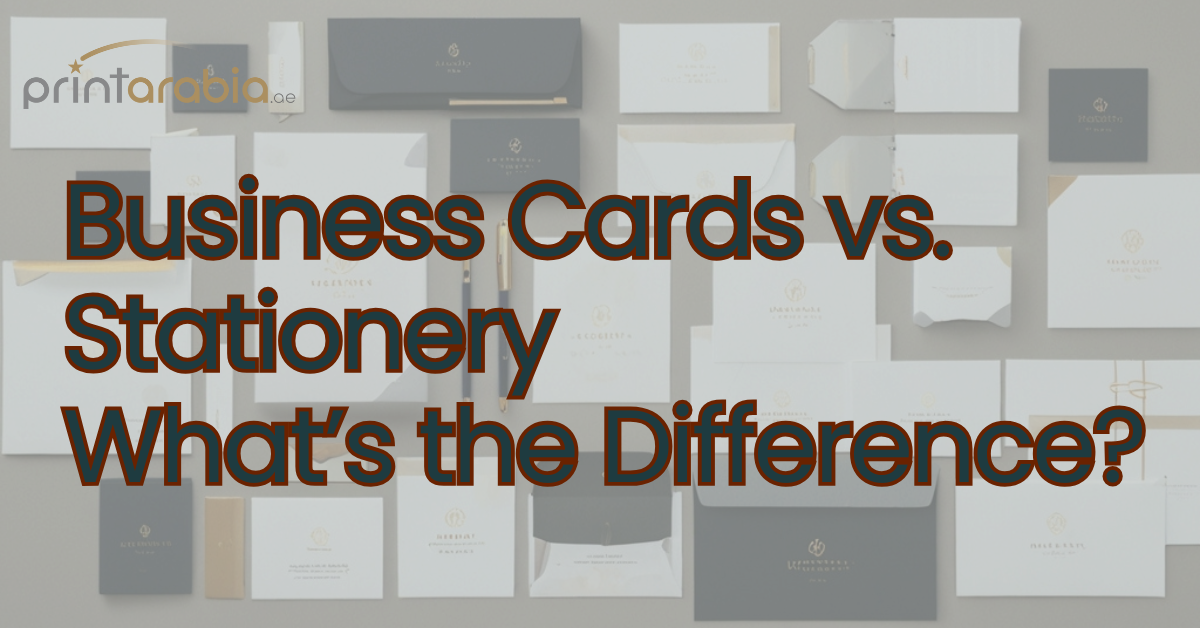
In the world of professional printing and business identity, the terms business cards and stationery often get mentioned in the same breath. Many entrepreneurs and marketing professionals wonder about the relationship between business cards vs. stationery. Are business cards actually a subset of stationery, or do they represent a completely separate category of printed materials? This confusion is understandable, especially when planning a cohesive brand identity system for your company.
What Is Stationery in a Business Context?
Traditional business stationery encompasses the collection of printed materials used for official correspondence and documentation. This typically includes:
- Letterheads: Pre-printed sheets featuring company information, logos, and contact details at the top
- Envelopes: Matching envelopes that carry the same branding elements as letterheads
- Notepads: Branded paper for internal notes, memos, or client communications
- Presentation folders: Branded folders for organizing and presenting documents
Corporate stationery serves as the foundation of formal business communication. When you send a proposal or official letter on branded letterhead, you’re not just sharing information—you’re wrapping that information in your company’s visual identity. This consistency in design across all stationery items builds recognition and reinforces professionalism with each touchpoint.
Are Business Cards Considered Stationery?
Business cards occupy an interesting position in the world of printed business materials. Technically speaking, business cards aren’t traditionally categorized as stationery in the strictest sense. While stationery primarily facilitates communication through writing and documentation, business cards serve a more direct networking and introduction function.
However, business cards share many characteristics with stationery items:
- They represent your brand visually
- They contain essential contact information
- They’re professionally printed materials
- They contribute to your overall brand system
Unlike general office supplies (pens, staplers, paper clips), business cards are part of your branded materials. They’re not used for writing or documentation but instead serve as portable brand ambassadors that facilitate direct person-to-person connections.
Business Cards vs. Stationery: How They Complement Each Other
When creating a professional brand identity, understanding the distinct yet complementary roles of business cards and stationery is essential:
| Business Cards | Stationery |
|---|---|
| Brief, direct networking tool | Comprehensive communication system |
| Exchanged during introductions | Used for ongoing correspondence |
| Contains individual contact details | Represents the organization as a whole |
| Designed for portability | Designed for formality and documentation |
While different in function, both business cards and stationery should share core design elements to create a cohesive brand experience. Your logo, typography, color palette, and visual style should carry across all materials. This consistency strengthens brand recognition and portrays professionalism.
For maximum impact, consider how these elements work together. For instance, when sending a proposal to a new client, include your business card with your letterhead documents. Explore premium letterhead printing options to match your business cards and strengthen your professional image. Similarly, pairing your custom envelopes with business cards enhances consistency across every client interaction.
When Should You Use a Full Stationery Kit?
While business cards are essential for nearly every professional, a complete stationery system becomes particularly valuable in certain business contexts:
Business Types That Benefit Most:
- Professional service firms (law, accounting, consulting)
- B2B companies with formal sales processes
- Creative agencies pitching to clients
- Medical and healthcare practices
- Financial institutions
- Educational organizations
Prime Usage Occasions:
- Client proposal packages
- Legal and contractual communications
- Welcome kits for new clients
- Trade shows and industry events
- Formal correspondence requiring a professional touch
For these scenarios, a coordinated suite that includes both business cards and full stationery components creates the strongest impression. When your potential client receives your proposal in a branded folder, reviews your offer on letterhead, and tucks your business card into their wallet, you’ve created multiple reinforcing touchpoints for your brand.
Conclusion
While business cards vs. stationery serve distinct functions in your professional communication toolkit, they work best when designed as complementary elements of a unified brand system. Business cards facilitate personal connections and networking, while stationery supports more formal, documented communications. Together, they create a professional ecosystem that represents your brand consistently across different contexts and touchpoints.
For businesses looking to make a lasting impression, investing in high-quality, coordinated business cards and stationery isn’t just about looking professional—it’s about creating a cohesive experience that reinforces your brand values and identity at every opportunity.
Elevate your brand presence with coordinated print essentials. Explore Print Arabia’s Business Card, letterhead, and envelope printing services to create a professional, memorable impression across every touchpoint.
Want to make a stronger first impression? Discover Why High-Quality Business Cards are essential for Brand Success in the UAE.
